Packaging line design determines manufacturing efficiency and product quality. Smart design reduces costs, increases throughput, and ensures consistent packaging standards across industries. Modern packaging lines integrate advanced technology, automated systems, and precise control mechanisms to meet diverse production requirements while maintaining operational flexibility and cost-effectiveness.
The global packaging machinery market continues expanding due to increasing consumer demand, e-commerce growth, and stricter quality regulations. Manufacturers require sophisticated solutions that balance speed, accuracy, and adaptability while meeting evolving sustainability requirements and regulatory compliance standards.
Core Design Elements
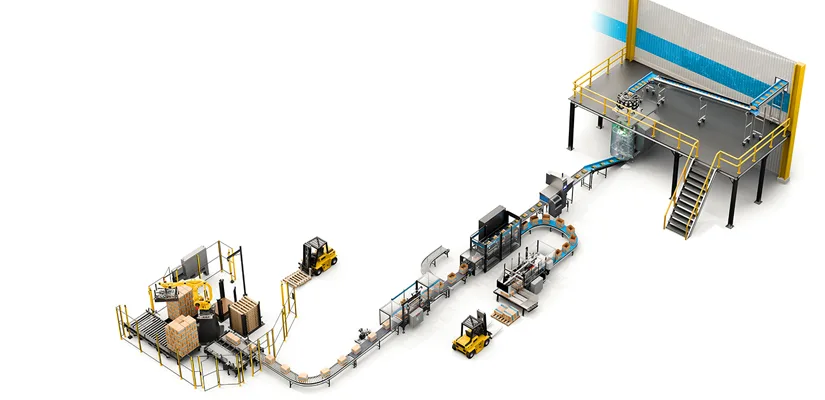
Layout Configuration Optimal layouts minimize product travel distance and eliminate bottlenecks. Standard configurations include linear, U-shaped, and L-shaped designs, selected based on facility constraints and production requirements. Linear layouts work best for high-volume, single-product operations, while U-shaped configurations maximize space utilization in compact facilities. L-shaped designs accommodate workflow interruptions and inspection points effectively.
Conveyor Systems Belt, roller, and chain conveyors form the transport backbone. Selection depends on product characteristics, weight capacity, and speed requirements. Belt conveyors handle lightweight products and fragile items, roller systems manage heavier loads efficiently, and chain conveyors provide precise positioning for automated operations. Variable speed controls and accumulation zones prevent product damage and maintain consistent flow rates.
Packaging Equipment Specialized machines handle weighing, filling, sealing, labeling, and wrapping operations. Equipment selection aligns with product type and packaging format specifications. Multi-format capability allows single machines to handle various container sizes and shapes, reducing capital investment and increasing operational flexibility. Servo-driven mechanisms ensure precise positioning and consistent performance across different production speeds.
Modern filling machines incorporate advanced technologies such as pumps filling for liquids, auger fillers for powders, and multihead weighers for granular products. These systems maintain filling accuracy within tight tolerances while accommodating product variations and environmental changes. Hygienic design features meet food safety and pharmaceutical regulations through easy cleaning access and contamination prevention measures.
Quality Assurance Integrated sensors and vision systems detect defects and maintain quality standards throughout the packaging process. Weight checks verify accurate filling, vision systems inspect label placement and print quality, and leak detection ensures package integrity. Statistical process control monitors performance trends and identifies potential issues before they affect product quality.
Automation Integration Automated systems handle repetitive tasks including sorting, packaging, and palletizing, reducing labor costs and human error. Programmable logic controllers coordinate equipment operations, while human-machine interfaces provide intuitive control and monitoring capabilities. Automated changeover systems reduce downtime when switching between product types or packaging formats.
Advanced automation includes robotic case packing, automated material handling, and intelligent product tracking systems. RFID technology and barcode scanning enable complete traceability from raw materials through finished goods distribution. Predictive analytics optimize production scheduling and preventive maintenance timing, maximizing equipment availability and reducing operational costs.
Industry Applications
Granular Products
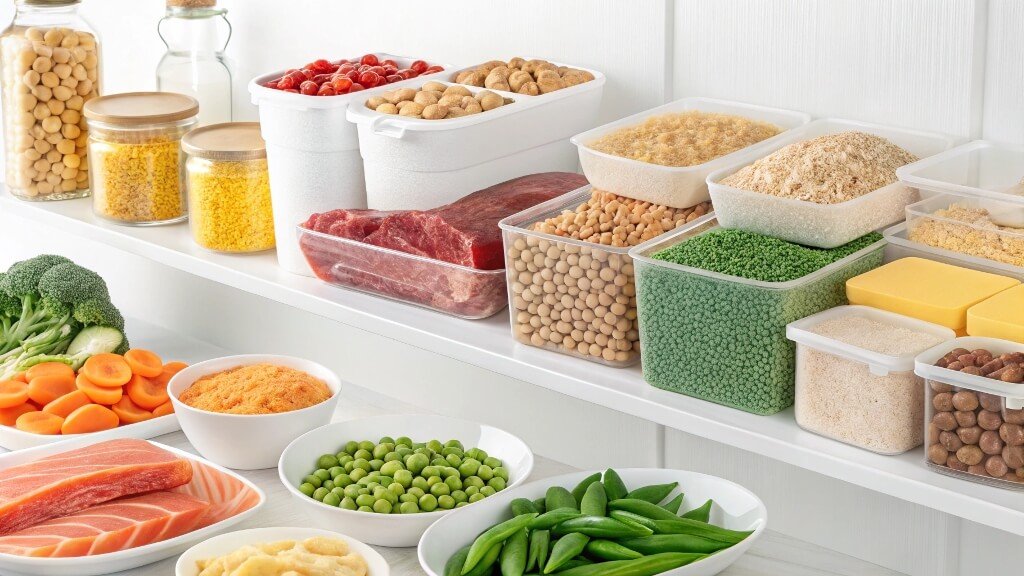
Industries: Food processing, agriculture, chemicals, pharmaceuticals
Packaging: Bags, boxes, pouches, bulk containers
Process: Bulk storage → precision weighing → automated filling → bag sealing → quality inspection (weight & metal)
Key Features: Dust-free handling, accurate portion control, anti-static systems for fine powders, and moisture protection sealing. Weighing accuracy typically ranges from ±0.1% to ±2% depending on product characteristics and package size.
Powder Products
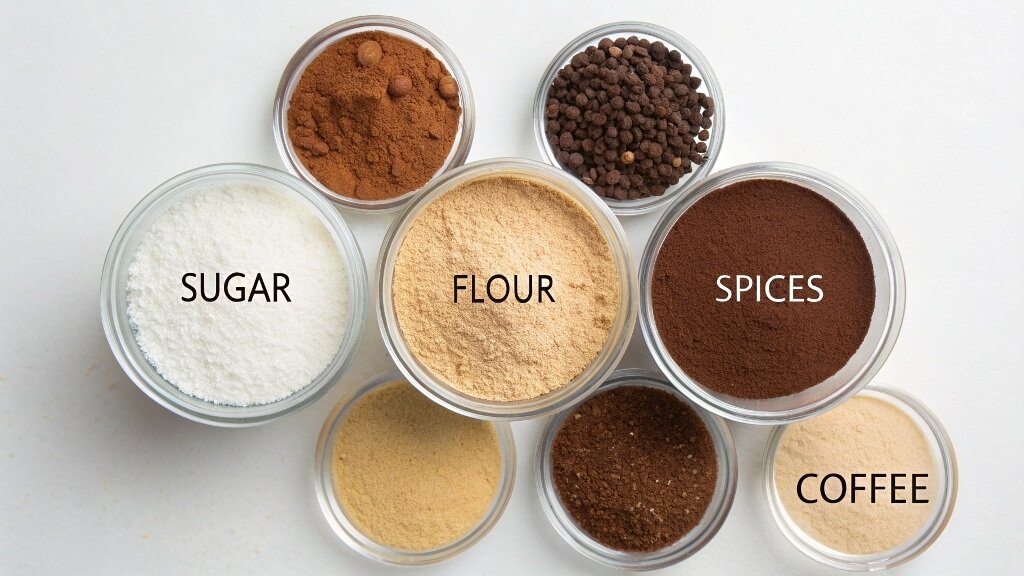
Industries: Food, pharmaceuticals, industrial chemicals, construction materials
Packaging: Bags, boxes, containers, bulk sacks
Process: Silo storage → auger/vacuum filling → dust-free sealing → automated packaging
Key Features: Dust containment systems, electrostatic discharge prevention, precision dosing mechanisms, and hermetic sealing options. Advanced powder handling prevents segregation and maintains product homogeneity.
Specialized Applications: Chemical powders require explosion-proof equipment and inert gas blanketing systems. Pharmaceutical powders demand sterile processing environments with validated cleaning procedures. Food powders need moisture protection and contamination prevention through nitrogen flushing and barrier packaging materials. Construction materials handling involves heavy-duty equipment designed for abrasive products and high-volume throughput requirements.
Liquid Products
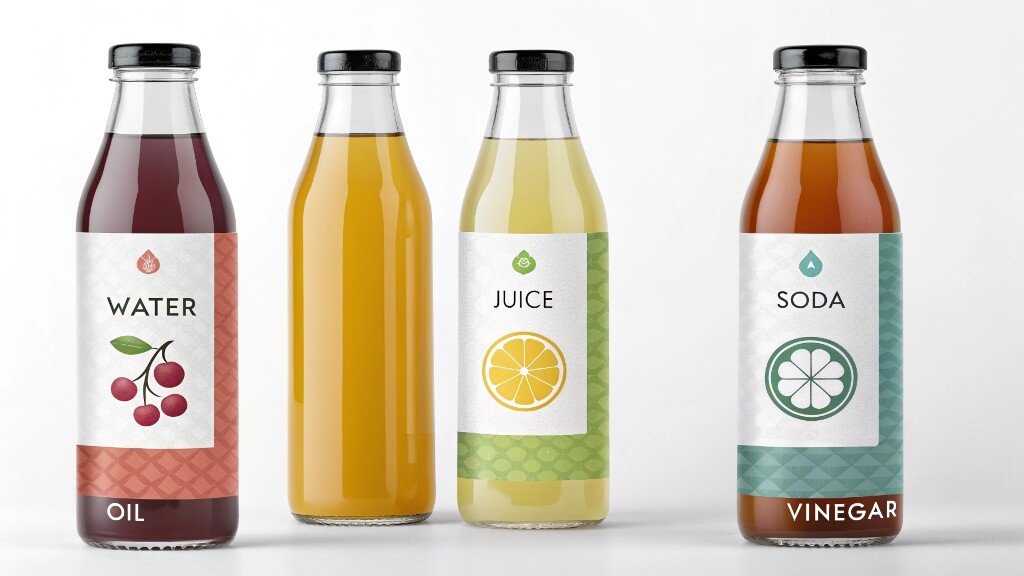
Industries: Pharmaceuticals, beverages, chemicals, cosmetics, food processing
Packaging: Bottles, containers, pouches, drums
Container Packaging Process: Storage tanks → filling machines → capping → labeling → case packing
Key Features: Viscosity compensation, foam control systems, sterile filling capabilities, and temperature-controlled processing. Filling speeds range from 30 to 120 containers per minute depending on product viscosity and container size.
Design Implementation
Requirements Analysis: Product specifications, production volumes, and packaging formats determine equipment selection and line configuration. Detailed analysis includes product flow characteristics, packaging material compatibility, environmental requirements, and regulatory compliance needs. Throughput calculations account for peak production demands and operational efficiency targets.
Equipment Selection: High-speed, versatile machinery with minimal maintenance requirements ensures long-term operational efficiency. Component standardization reduces spare parts inventory, while modular designs enable future expansion and modification. Equipment warranties, service support availability, and training programs influence selection decisions.
Layout Optimization: Simulation software identifies optimal workflows and prevents bottlenecks before installation. 3D modeling visualizes equipment placement and operator access requirements. Material flow analysis optimizes conveyor routing and minimizes handling points. Ergonomic considerations ensure safe and efficient operator interaction.
Automation Strategy: Robotic systems, automated guided vehicles, and smart sensors maximize productivity and accuracy. Integration planning addresses communication protocols, safety systems, and operator interfaces. Scalable automation allows gradual implementation based on production growth and return on investment requirements.
Sustainability Focus: Eco-friendly materials, energy-efficient machinery, and waste reduction systems meet environmental standards. Packaging material optimization reduces waste while maintaining product protection. Energy recovery systems capture and reuse process heat. Water conservation measures minimize environmental impact in cleaning operations.
Sustainable packaging initiatives include biodegradable film materials, recyclable container designs, and reduced packaging weight without compromising protection. Renewable energy integration through solar panels and wind power reduces carbon footprint. Waste-to-energy systems convert packaging waste into process steam or electricity. Circular economy principles guide material selection and end-of-life disposal strategies.
Smartpack Solutions
Smartpack specializes in comprehensive packaging lines for diverse product types and formats, delivering customized solutions that meet specific industry requirements:
Granular Systems
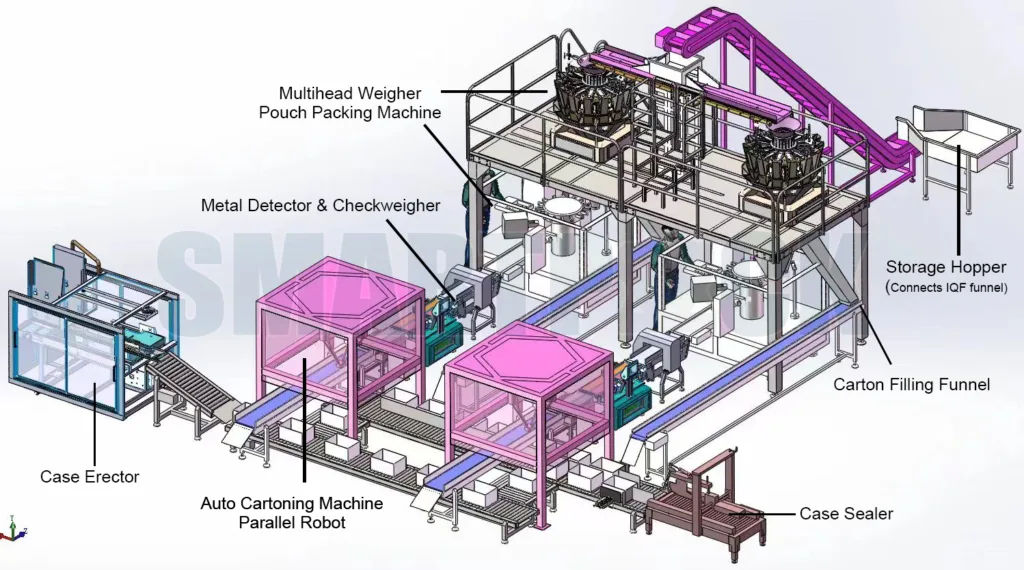
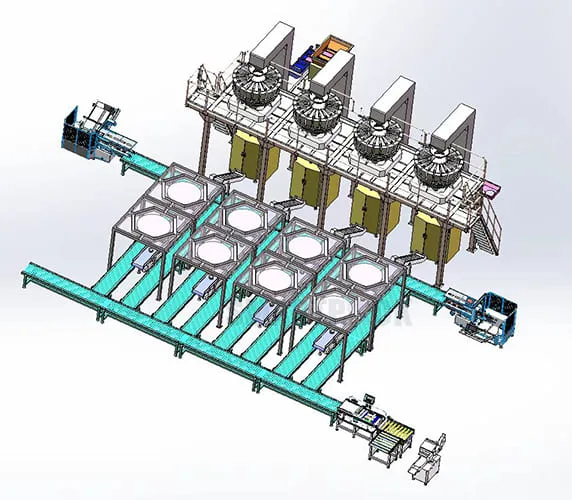
- High-precision weighing and filling with accuracy levels up to ±0.1%
- Heat sealing and automated labeling systems
- Custom conveyor configurations for optimal product flow
- Anti-segregation handling for mixed granular products
- Dust collection and containment systems
Powder Systems
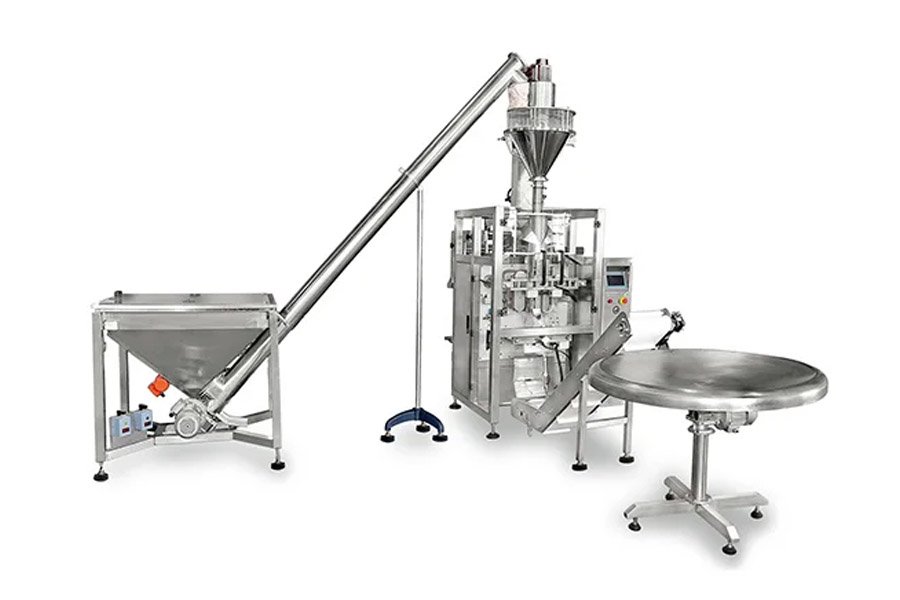


- Dust-controlled filling operations with servo control
- Specialized sealing technology preventing product contamination
- Contamination-free handling with enclosed transfer systems
- Electrostatic discharge protection for explosive powders
- Precise dosing with minimal product waste
Liquid Systems

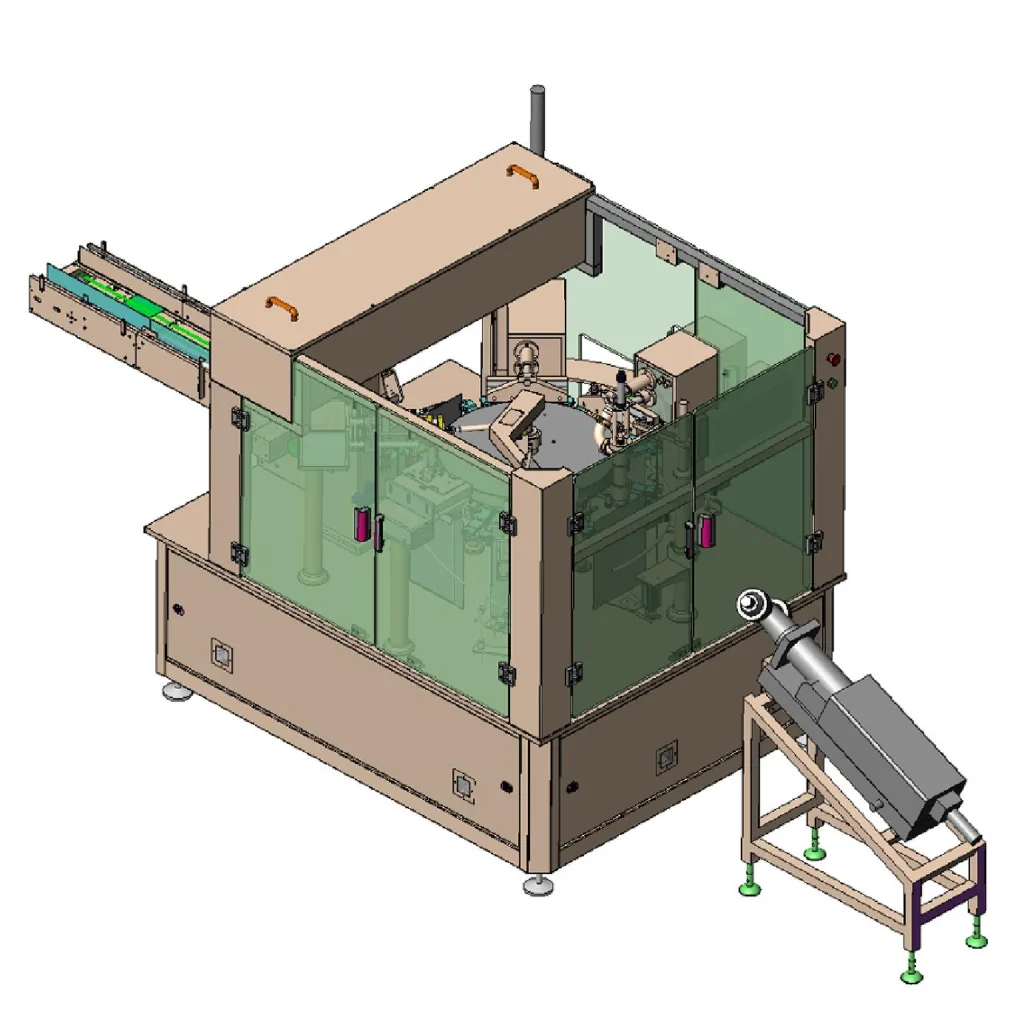
- Multi-format filling capabilities handling viscosities from water-thin to paste-like
- Automated capping and labeling with vision verification
- Spillage-minimized transport with drip-free designs
- CIP (Clean-in-Place) systems for hygienic processing
- Temperature control for heat-sensitive products
Integration Capabilities Smartpack systems integrate seamlessly with existing production lines, ERP systems, and quality management software. Remote monitoring capabilities enable real-time performance tracking and predictive maintenance scheduling.
Advanced Control Systems Distributed control systems provide centralized monitoring and control while maintaining local operational capability. Recipe management systems store and recall packaging parameters for different products, ensuring consistent quality and reducing setup time. Data acquisition systems collect production statistics for analysis and optimization. Emergency stop systems and safety interlocks protect operators and equipment during normal operations and maintenance activities.
Training and Support Services Comprehensive operator training programs ensure safe and efficient equipment operation. Technical documentation includes detailed operating procedures, maintenance schedules, and troubleshooting guides. Remote support capabilities enable real-time assistance through video conferencing and augmented reality systems. Spare parts programs guarantee component availability and minimize downtime risks.
Packaging Equipment Purchase Process
Smartpack follows a structured procurement process ensuring optimal equipment selection and successful implementation:
1. Initial Inquiry: Customers submit product specifications, production requirements, and facility constraints. Initial consultation identifies basic equipment needs and preliminary cost estimates. Technical questionnaires capture detailed product characteristics, packaging preferences, and special requirements.
2. Detailed Solution Design: Engineering teams develop customized packaging solutions based on specific requirements. Detailed proposals include equipment specifications, layout drawings, performance guarantees, and comprehensive cost breakdowns. Multiple configuration options accommodate different budget levels and future expansion needs.
3. Contract and Deposit: Upon proposal approval, formal contracts specify delivery schedules, performance criteria, and payment terms. Initial deposits typically range from 30-40% of total project value, securing production scheduling and material procurement. Contract terms include acceptance criteria, warranty provisions, and service support agreements.
4. Manufacturing Phase: Specialized production teams manufacture equipment according to approved specifications. Quality control procedures verify component accuracy and performance standards throughout the manufacturing process. Regular progress updates keep customers informed of production milestones and delivery schedules.
5. Assembly and Integration: Complete systems undergo full assembly and calibration in Smartpack facilities. All mechanical, electrical, and control systems receive comprehensive testing and adjustment. Integration testing verifies proper communication between system components and external interfaces.
6. Performance Testing: Rigorous testing procedures validate system performance against specified criteria. Customer products undergo trial runs demonstrating packaging quality, speed, and reliability. Performance documentation provides baseline data for ongoing operational monitoring.
7. Export Packaging: Systems receive professional export packaging in custom wooden crates designed for international shipping. Moisture barriers, shock absorbers, and secure fastening systems protect equipment during ocean transport. All crates include detailed packing lists and handling instructions.
8. Final Payment and Shipment: Final payments complete upon successful testing and export packaging. Shipping documentation includes bills of lading, certificates of origin, and customs declarations. Tracking information enables customers to monitor shipment progress from departure to destination port.
9. Installation and Commissioning: Smartpack technicians provide on-site installation, commissioning, and operator training services. Comprehensive startup procedures ensure optimal performance and operator competency. Final acceptance testing confirms system performance in the customer’s production environment.
Post-Installation Support Extended warranty programs provide additional protection beyond standard coverage periods. Preventive maintenance contracts ensure optimal equipment performance through scheduled service visits. Upgrade programs keep systems current with latest technology developments. Performance optimization services identify efficiency improvements and cost reduction opportunities through detailed analysis of production data and operational procedures.
Common Challenges
Customization Balance: Meeting specific product requirements while maintaining operational standardization. Modular designs enable customization without compromising proven performance characteristics. Standard interfaces allow custom components to integrate seamlessly with proven subsystems.
System Integration: Ensuring seamless communication between diverse equipment components. Standardized communication protocols and comprehensive testing procedures prevent integration issues. Centralized control systems coordinate all equipment functions while maintaining individual component accessibility.
Maintenance Access: Designing for easy component access and routine maintenance procedures. Equipment layouts prioritize maintenance accessibility without compromising production efficiency. Predictive maintenance systems identify potential issues before they cause unplanned downtime.
Investment Optimization: Balancing initial equipment costs with long-term operational savings. Life-cycle cost analysis demonstrates total ownership costs including energy consumption, maintenance requirements, and productivity benefits. Flexible financing options accommodate various budget constraints and cash flow requirements.
Regulatory Compliance: Meeting evolving regulatory requirements across different markets and applications. FDA compliance for food and pharmaceutical applications includes validation documentation and traceability systems. CE marking ensures European safety standards compliance. ATEX certification addresses explosive atmosphere requirements for chemical processing. GMP compliance supports pharmaceutical manufacturing through documented procedures and validation protocols.
Technology Trends
Smart Automation: AI-driven robotics handle complex packaging tasks with improved precision and flexibility. Machine learning algorithms optimize packaging parameters based on real-time performance data. Vision-guided robots adapt to product variations without manual programming adjustments.
IoT Connectivity: Real-time monitoring enables predictive maintenance and operational optimization. Cloud-based analytics provide insights into production trends and efficiency opportunities. Remote diagnostics reduce service response times and maintenance costs.
Sustainable Operations: Biodegradable materials and energy-efficient systems reduce environmental impact. Circular economy principles guide packaging design and material selection. Carbon footprint reduction initiatives include renewable energy integration and waste-to-energy systems.
Flexible Manufacturing: Modular designs adapt quickly to changing packaging requirements and product variations. Quick-changeover systems minimize downtime between different product runs. Scalable architectures accommodate production growth without complete system replacement.
Digital Transformation: Industry 4.0 technologies transform traditional packaging operations through connected systems and data analytics. Digital twins enable virtual testing and optimization before physical implementation. Blockchain technology provides secure supply chain tracking and authentication. Augmented reality systems assist operators with complex procedures and maintenance tasks. Cloud computing enables global system monitoring and management from centralized control centers.
Conclusion
Effective packaging line design integrates layout optimization, equipment selection, and automation strategy to maximize efficiency and quality. Smartpack delivers tailored solutions for granular, liquid, and powder products across multiple packaging formats, ensuring competitive advantage through advanced technology and sustainable practices.
The structured procurement process guarantees successful implementation from initial inquiry through final commissioning. Comprehensive testing, professional packaging, and expert installation services ensure optimal performance and long-term reliability. As packaging requirements continue to evolve, Smartpack remains committed to innovative solutions that meet changing market demands while maintaining operational excellence and environmental responsibility.
FAQ
1. What factors should I consider when choosing a packaging line?
Key considerations include product characteristics (granules, liquids, powders), production volume requirements, packaging formats, available floor space, budget constraints, and future expansion plans. Product flow properties, shelf life requirements, and regulatory compliance needs also influence equipment selection. Consider integration with existing systems and operator skill levels when evaluating options.
2. How long does it take to design and manufacture a custom packaging line?
Timeline varies based on complexity and customization level. Standard configurations typically require 8-12 weeks from order confirmation to shipping. Complex custom systems may require 16-20 weeks including design, manufacturing, testing, and documentation. Project timelines include engineering design (2-4 weeks), manufacturing (6-12 weeks), assembly and testing (1-2 weeks), and export preparation (1 week).
3. What maintenance is required for packaging equipment?
Regular maintenance includes daily cleaning and inspection, weekly lubrication of moving parts, monthly calibration checks, and quarterly comprehensive servicing. Preventive maintenance schedules depend on operating hours, product characteristics, and environmental conditions. Critical components like sensors, seals, and drive systems require more frequent attention. Proper maintenance extends equipment life and maintains performance specifications.
4. Can packaging lines handle multiple product types?
Modern packaging lines offer significant flexibility through quick-changeover capabilities and modular designs. Multi-format machines accommodate different container sizes and product types with minimal setup time. Recipe management systems store parameters for different products, enabling rapid product transitions. However, extreme product variations may require dedicated equipment or extensive changeover procedures.
5. What safety features are included in packaging systems?
Comprehensive safety systems include emergency stops, safety interlocks, light curtains, and pressure-sensitive mats. Enclosed dangerous areas prevent operator contact with moving parts. Lockout/tagout procedures ensure safe maintenance operations. Guards and barriers protect operators from pinch points and rotating equipment. Safety training and proper procedures are essential components of safe operation.
6. How do I calculate return on investment for packaging equipment?
ROI calculations include initial equipment cost, installation expenses, operating costs (labor, energy, maintenance), and productivity benefits. Factor in labor savings from automation, reduced material waste, improved product quality, and increased throughput. Typical payback periods range from 1-3 years depending on production volume and automation level. Consider both tangible and intangible benefits in your analysis.
7. What training is provided with new equipment?
Comprehensive training programs cover equipment operation, maintenance procedures, troubleshooting, and safety protocols. Training includes classroom instruction, hands-on operation practice, and documentation review. Programs typically last 3-5 days depending on system complexity. Advanced training covers recipe management, performance optimization, and basic troubleshooting. Ongoing support includes remote assistance and refresher training as needed.
8. Can existing packaging lines be upgraded or modified?
Most packaging lines can be upgraded with new components, automation systems, or additional capabilities. Common upgrades include adding vision inspection systems, implementing automated changeovers, or increasing speed capabilities. Retrofit options depend on existing equipment condition and compatibility. Gradual upgrades allow spreading investment over time while maintaining production continuity.
9. What regulatory compliance is required for packaging equipment?
Compliance requirements vary by industry and geographic location. Food applications require FDA approval and sanitary design features. Pharmaceutical equipment needs GMP compliance and validation documentation. European markets require CE marking for safety compliance. Chemical applications may need ATEX certification for explosive atmospheres. Consult regulatory experts for specific requirements in your industry and markets.
10. How do I determine the right production capacity?
Capacity planning considers current production needs, growth projections, seasonal variations, and efficiency factors. Account for changeover time, maintenance requirements, and quality control procedures when calculating effective capacity. Design systems with 20-30% excess capacity to handle peak demands and unexpected growth. Consider both theoretical maximum speed and realistic operating conditions in your calculations.
